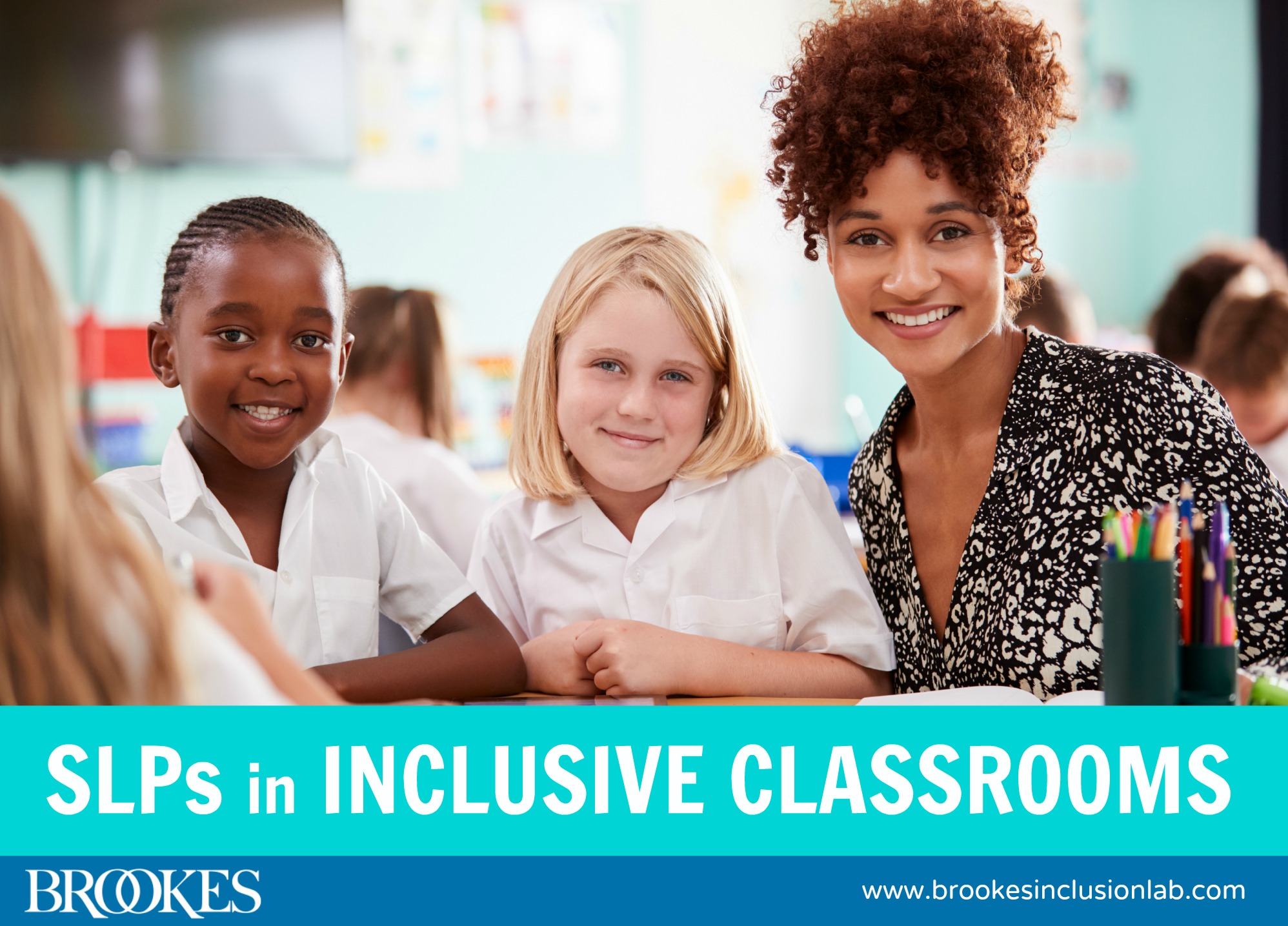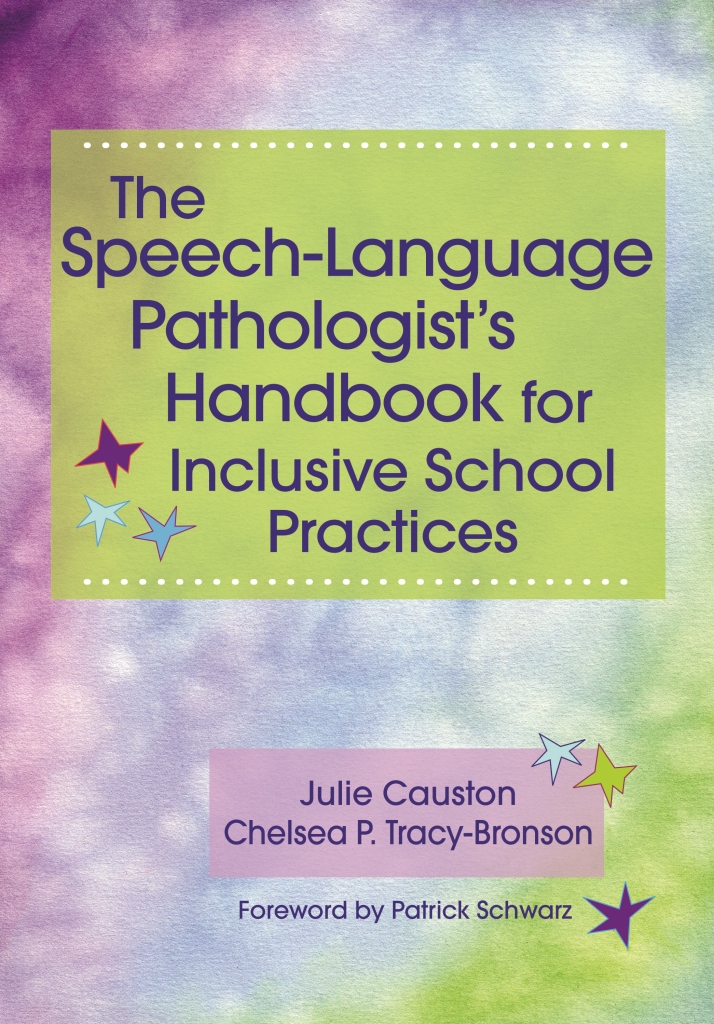SLPs in Inclusive Classrooms: 9 Questions Answered!
June 2, 2020
In an inclusive classroom, every member of the school team is integral to the creation of a learning environment that welcomes and meets the needs of each unique learner. Speech-language pathologists, who provide students with the communication supports they need to access the curriculum, are no exception. As author and inclusion expert Julie Causton says in the book that inspired today’s post, “SLPs who position themselves as critical to inclusion disrupt traditional thinking about therapy services provided in a pull-out setting. They demonstrate how SLPs are equally important partners in the work of doing inclusion well.”
 How can SLPs best support all their students and operate as an essential part of the inclusive school team? Today, we’re bringing you nine key questions SLPs ask about inclusive education—and specific, thoughtful answers from Julie Causton and Chelsea P. Tracy-Bronson, excerpted and lightly adapted from their book The Speech-Language Pathologist’s Handbook for Inclusive School Practices. (Have a question that’s not on the list below? Add it in the comments section below, and we’ll get it answered for you!)
How can SLPs best support all their students and operate as an essential part of the inclusive school team? Today, we’re bringing you nine key questions SLPs ask about inclusive education—and specific, thoughtful answers from Julie Causton and Chelsea P. Tracy-Bronson, excerpted and lightly adapted from their book The Speech-Language Pathologist’s Handbook for Inclusive School Practices. (Have a question that’s not on the list below? Add it in the comments section below, and we’ll get it answered for you!)
Q. What’s wrong with pull-out speech and language therapy?
A. According to ASHA, the purpose of school-based speech and language therapy is “to optimize individuals’ ability to communicate and swallow, thereby improving quality of life.” In other words, SLPs provide supports that help students communicate during their school day. Any skills, routines, activities, or performance tasks that students need to work on should be learned and practiced in their naturally occurring context—that is, the least restrictive environment.
Also, students with disabilities have the right to learn and socialize alongside their grade-level peers. Pull-out provision of any kind of service or support has deleterious effects on one’s self-esteem and ability to learn and disrupts a sense of belonging. Many therapists across the country are transforming their practices, and their therapy supports are now portable, meaning they can be delivered right in these naturally occurring contexts.
Q. I have so many students to support! How can I get to them all inclusively?
A. One thing that has become clear in the law is that staff convenience is not a reason to pull students. Therefore, you might determine which students need direct support, which students can receive consult services, and for which students you will stop by to monitor progress. Then, arrange your schedule to match those needs. Instead of thinking about your workload as static and unchanging (e.g., 11:30–11:45, Zack receives oral motor stimulation in the speech and language room), you begin to think of appropriate times to provide such services, and generally problem solve across Zack’s day.
Q. How do I meet the number of minutes for SLP services on the IEPs unless I pull students out?
A. Services can be carried out in many ways. The law suggests that services are portable and should be brought to the student. Therefore, your time could be spent “pushing in” to the general education classroom, running a center, or recommending ideas to the other educators on how to carry out the specific skills while they teach. Your time could be spent modifying or adapting the material so the student can be successful in the general education classroom and throughout the school day.
Q. I’m not sure what I’m supposed to be doing when I provide push-in services. We (the general education teacher and I) have never co-designed or collaborated to plan lessons, so mostly I just sit and support two students who receive speech-language pathology as part of their IEP goals. What should I do?
A. Set up a time to meet with the general education teacher. Ask questions such as, “How can we both have useful roles during science, while meeting Zack and Priscilla’s therapy goals?” “When you are giving whole-class instructions, how can I support you?” “How can you integrate Zack’s therapy goals during the rest of the day?” These conversations that merge academic learning experiences with therapy interventions are crucial in ensuring that IEP goals are generalized throughout the day.
Q. Can I ever teach an entire class by myself?
A. An SLP can lead a whole-class lesson and have a purposeful co-teaching role. The general educator and therapist can work together to develop a co-teaching relationship and work as a team to deliver the therapeutic intervention and academic learning experiences. This works because there is a certified teacher in the room and the lesson was co-planned.
Q. What are some ways I can support my students’ inclusion and expand their skills outside of class?
A. Here are some options for you:
Before/after school: Many SLPs find that before or after school time is perfect for supporting skills. You might find a pocket of time after school to practice social communication skills with your student, or practice swallowing during breakfast at school.
In the hallway: Have the students engage in “partner Simon Says.” During a 5-minute transition, ask students to partner up and do mirror activities with their partners as they walk down the hall. For example, have them stick out their tongue, say tongue twisters, repeat silly sounds, and more. Many of these are skills you may practice in your therapy room—but with this between-class activity, everyone can benefit from extra practice and transitions are more fun.
At free or choice time: Help students choose the activities they want to do and which peers they want to participate with them. For example, if your student wants to develop the ability to initiate conversation and join a group during recess, have a 5-minute conference with them to brainstorm three ways to join a group to play with during recess. Take the ideas from this conversation and write a social script that your student can place in their locker. Your student can then review the social script each day to prepare for recess.
Q. What role do I play in supporting students who receive speech-language services when I am not in their classroom all day?
A. Through indirect consultation, you can provide recommendations to the educational team about accommodations and modifications that support a student in the general education curriculum. You will not always have the role to implement your ideas. Yet, these recommendations are immensely beneficial to allow the student to benefit from special education and “specially designed instruction” under IDEA.
Q. My team members want me to sit next to the student and provide direct support when I am in the classroom. I think there are better ways—what should I do?
A. First communicate alternatives to the side-by-side support. Modify the work, change the writing utensil, give written prompts on a sticky note. You should provide the type and level of support that the team deems appropriate. However, if you think it is not helpful to the student, work with your team and discuss when it might be appropriate to fade your support: What would fading look like for this student? What other types of support can be in place to allow for student success?
Q. I understand why I should fade my support, but I worry that will not count as student contact minutes. What can I do while I am fading my support?
A. This is a common concern. Direct contact minutes does not mean you are in direct contact with students (e.g., touching the student, hand-over-hand support, sitting at their table). Instead it means they are engaged in learning experiences that you have helped to construct with your expertise. When they are practicing a skill (e.g., verbal turn taking), you can get students started and walk around the room helping others. When you return, you can help cue the students and continue moving. When moving away from a student, you can support other students, prepare for an upcoming class by creating modifications, or take data.
***
All inclusive school teams need a great SLP on board. Today’s post offered some tips on how SLPs can best support students and partner with other team members. Ask your question below if yours wasn’t answered today—and for more guidance on succeeding in an inclusive classroom as a speech-language pathologist, check out the book!
 The Speech-Language Pathologist’s Handbook for Inclusive School Practices
The Speech-Language Pathologist’s Handbook for Inclusive School Practices
By Julie Causton, Ph.D., & Chelsea P. Tracy-Bronson, M.A.
This is the practical, friendly guide SLPs need to go beyond pull-out services and deliver successful communication and language supports as part of an inclusive school team. Packed with immediately useful strategies, relatable examples, and invaluable insights from experienced SLPs, this guidebook is key to helping students with disabilities improve their communicative functioning so they can access the curriculum and fully participate in classroom routines and activities.
LEARN MORE NOW




Write a Comment
Your email address will not be published. Required fields are marked *
Post a Comment